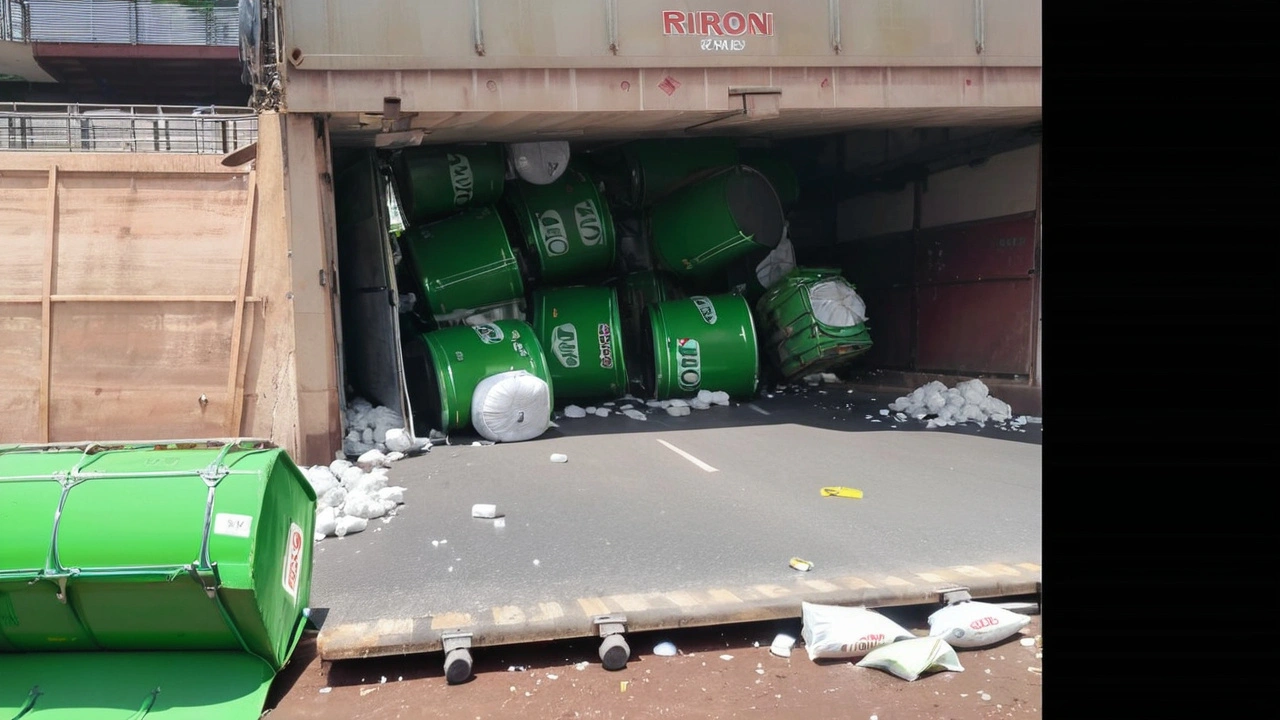A Serious Accident in Rironi: What Happened?
On July 21, 2024, residents of Rironi in Kiambu County were alarmed by the sight of a lorry lying overturned with drums of highly toxic sodium cyanide spilling onto the ground. This shocking incident occurred in the Kambembe area and was confirmed by Kiambu Base Commander, Aggripina Lugonzo. According to Lugonzo, the accident was a self-involved mishap though the exact cause is still under investigation.
The scene became a hub of activity as law enforcement and response teams moved quickly to secure the area and prevent any harm to the public. Media reports and eyewitness accounts described a chaotic yet carefully managed response. Among those deployed to stabilize the scene were colleagues from the Limuru OCS, who worked alongside Commander Lugonzo to ensure safety protocols were followed to the letter.
Emergency Response and Containment
Securing the accident scene was a top priority given the highly toxic nature of sodium cyanide. This chemical is known for its extreme toxicity, posing immediate health risks such as headaches, dizziness, and vomiting upon inhalation or ingestion. Authorities moved rapidly to keep the public at a safe distance and initiated efforts to contain the spill. Even small quantities of sodium cyanide can cause significant harm, which underscores the urgency of their response.
Expert teams were called in to manage the complex task of clearing the spilled sodium cyanide thoroughly and safely. The transporting company, responsible for the lorry and its hazardous cargo, was notified and dispatched a replacement truck to retrieve the intact containers. The situation necessitated professional handling to mitigate any potential environmental damage. Sodium cyanide is not only harmful to human health but also poses a substantial threat to aquatic life, risking extensive fish kills and long-term damage to ecosystems.
Public Safety Measures
As authorities extended their efforts to manage the spill, they issued warnings to the public to steer clear of the affected area. Residents were urged to remain vigilant and report any related symptoms they might experience, such as the aforementioned dizziness or sickness, to healthcare professionals immediately. Local environmental agencies were also alerted to monitor any signs of contamination in nearby water sources, as the chemical can seep into the ground and water systems, thereby impacting both the immediate and distant environment.
In addition to physical containment, law enforcement began an investigation to determine the root cause of the accident. Understanding the events leading up to the lorry’s overturning is crucial to preventing similar incidents in the future. Preliminary reports suggest that driver error, mechanical failure, or external road conditions could have contributed to the accident, but further analysis is required to draw definitive conclusions.
Community Reactions and Precautions
The incident has understandably spurred anxiety and concern among Rironi residents, prompting discussions about the transportation of hazardous materials through populated areas. Many locals have voiced their fears and frustrations, calling for more stringent regulations and oversight to prevent future accidents of this nature.
Local authorities and the transporting company have been urged to review their safety protocols and ensure that all necessary precautions are in place when conveying toxic substances. This includes better training for drivers, more rigorous vehicle maintenance checks, and enhanced emergency response strategies.
The Bigger Picture: Hazardous Chemicals in Transit
This incident brings to light broader issues surrounding the transportation of hazardous materials. Sodium cyanide is frequently used in various industrial processes, including mining, where it plays a role in extracting gold and other precious metals. Its wide-range use means that the risk of spillage during transportation is an ongoing concern.
The risks associated with transporting such dangerous goods necessitate robust safety measures and strict compliance with regulatory standards. Ensuring that only well-maintained vehicles and highly trained personnel handle these materials is essential to safeguarding public health and the environment. The recent lorry accident in Rironi serves as a stark reminder of the dire consequences that can arise from lapses in safety.
Next Steps and Continuing Vigilance
In the aftermath of the spill, clean-up efforts and investigations are poised to continue for the foreseeable future. Environmental experts will closely examine the spill site to assess any long-term impacts on the local ecosystem and implement remediation measures if necessary. Tracking potential contamination in water bodies and soil will be critical in preventing secondary effects on wildlife and plant life in the region.
As we await further updates on the cause of the accident and comprehensive reports on any ecological damage, the focus remains on public safety and environmental protection. The incident underscores the importance of preparedness and proactive measures when dealing with hazardous materials.
The events in Rironi have resonated beyond the local community, sparking discussions at higher levels of government and within industry circles about possible reforms and enhanced safety protocols. Ensuring that such incidents are minimized in the future requires a concerted effort from all stakeholders, including policymakers, businesses, and emergency response teams.
Ultimately, the Rironi sodium cyanide spill serves as a somber yet crucial learning experience. It highlights the inherent risks of transporting dangerous substances and the absolute necessity of being prepared to handle accidents competently. Continued vigilance, timely response, and comprehensive precautionary measures will be essential to prevent future occurrences of this nature.







Vinay Menon July 22, 2024
This is terrifying. I live near a major highway and never thought about how many toxic trucks roll past my house every day. One mistake, one bad tire, one sleepy driver-and boom. We’re all just one accident away from a nightmare.
Why do we let this stuff move through towns at all? Couldn’t we route it through industrial zones only? People’s kids play outside here. This shouldn’t be normal.
Doloris Lance July 22, 2024
The regulatory framework for HAZMAT transport is fundamentally broken. The DOT’s 49 CFR Part 172 labeling requirements are outdated, and the FMCSA’s driver qualification standards are woefully insufficient for Class 6.1 toxic substances. There’s zero real-time monitoring of cargo integrity during transit. This isn’t negligence-it’s systemic institutional failure.
Until we mandate IoT-enabled pressure/leak sensors on all cyanide containers and require biometric driver fatigue monitoring, this will keep happening. And no, ‘training’ isn’t a solution. It’s a Band-Aid on a severed artery.
Carolette Wright July 22, 2024
I just saw a video of someone picking up a drum like it was a grocery bag. Like… what?? Who lets that happen?? My heart is pounding just thinking about it.
Beverley Fisher July 23, 2024
OMG I can’t even sleep right now. I kept imagining my dog sniffing one of those drums… what if it was my kid? I’m crying. This is the kind of thing that should never happen. Ever. Who’s even driving these things??
Anita Aikhionbare July 23, 2024
This is why Africa can’t develop. Foreign companies bring their dangerous waste and chemicals here because they think we’re too dumb to protect ourselves. First it’s e-waste, now this? When will the world stop treating us like a dumping ground?
Mark Burns July 24, 2024
I swear to god if this was a truck full of iPhones, the whole world would be on fire. But it’s poison? Nah, let’s just post a 300-word article and call it a day. The real tragedy isn’t the spill-it’s how we’ve all become numb to it. We’re all just scrolling while the world burns.
jen barratt July 25, 2024
There’s a quiet horror in how routine this has become. We don’t gasp anymore when a truck spills something deadly-we just sigh and say, ‘Oh, another one.’ We’ve normalized danger. We’ve turned risk into background noise.
But here’s the thing: the people living near these routes? They never got a choice. They didn’t sign up for this. Maybe the real question isn’t ‘How do we prevent this?’ but ‘Why did we let this become someone else’s problem?’
Evelyn Djuwidja July 25, 2024
This is precisely why Western nations should not be exporting hazardous logistics infrastructure to developing regions. The regulatory capacity in Kenya is inadequate to manage such materials. The real failure lies in the international complicity that allows this to occur under the guise of ‘economic development.’
Alex Braha Stoll July 26, 2024
So we’re supposed to be impressed that they ‘moved quickly’? Like, congrats, you contained the poison after it already leaked into the soil and maybe the water table. That’s not heroism. That’s damage control. The real hero would’ve been the person who said, ‘Let’s not haul this crap through a town in the first place.’
Rick Morrison July 26, 2024
The chemical’s LD50 for humans is approximately 5–10 mg/kg, meaning ingestion of less than a teaspoon can be lethal. Sodium cyanide’s volatility and rapid absorption through mucous membranes make it particularly dangerous in open-air spills. The fact that no fatalities were reported is a miracle-and a testament to the rapid response protocols deployed. However, this incident underscores the urgent need for standardized, geolocated emergency response databases for HAZMAT incidents in low-resource regions. Without real-time coordination tools, even well-intentioned efforts are reactive, not preventative.
Monika Chrząstek July 27, 2024
i just hope everyone is okay… and that the drivers get the support they need too. this job is so stressful and no one talks about how scared they must be every time they drive with something this dangerous. please be kind to the people who do the hard, invisible work. we all need them. <3